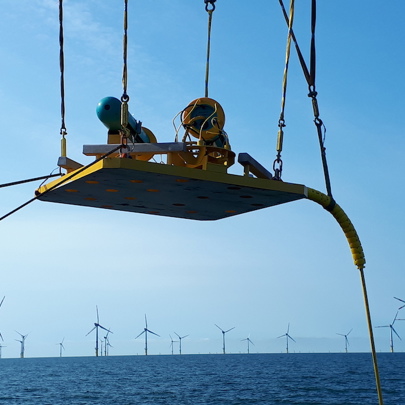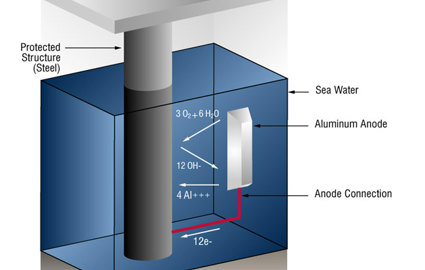Neptune Spar
RetroBuoy installed on a SPAR structure in the Gulf of Mexico to supplement failing anodes on the hull

RetroBuoy™ installed on the Neptune SPAR structure to supplement hull’s failing cathodic protection
In August / September 2009, Deepwater Corrosion Services retrofitted the cathodic protection system on the Neptune Spar. The original cathodic protection system on the hull was approximately 300 sacrificial aluminum anodes. Neptune required a life extension significantly in excess of the original 15 year service life, including the cathodic protection (CP) system. At the request of the operator, DCSI designed, supplied and commissioned a 15-year life-extension impressed-current CP system (ICCP). The retrofit CP system consisted of:
• 2 x custom 500 Amp RetroBuoys™ with shear keys
• 2 x transformer rectifiers
• 6,660 plus feet of dynamic 7-conductor 3/0 AWG subsea power cable
• 2 x Polatrak® DR 3™ reference electrodes (installed at Neptune's keel during the cable pull-in)



Installation time: 72 hours
Installed in 1997, Neptune is a classic spar located in the Gulf of Mexico (Viosca Knoll block 826), in approximately 1,930 feet of seawater. Flowlines and umbilicals are pulled in through three sets of blister tubes located on the side of the spar hull.
The two RetroBuoys™ were manufactured in Deepwater's Houston, Texas facilities and terminated onto JDR cables, dockside, in Fourchon, Louisiana. Both assemblies were then loaded onto Oceaneering's 254-feet long multi-service vessel, Ocean Intervention II. For each system, the RetroBuoy™ was deployed through an A-frame to its seabed target box. The RetroBuoys™ were designed with a shear key mud mat to pierce the soil and withstand forces exerted by meteorological / oceanographic conditions and the Spar's lateral drilling offset.
The cathodic-protection monitoring system comprises two each Polatrak® DR-3™ dual reference electrodes terminated to dual armored, shielded, twisted pair 12 AWG cables. The DR-3™ probes are mounted near the lower opening of the blister tube at the keel. The cables were piggy-backed up along the section of subsea power cable routed through the blister tubes and terminated into a topside junction box. Cathodic protection potential measurements are monitored and recorded by the on-board SCADA system.
The entire subsea system was installed in less than 72 hours.
Retrobuoy Video

Install begins
Overboarding of the first of two RetroBuoys through the stern A-frame and down the lay chute.

Pull-in head
JDR’s pull-in head, associated bend strain reliever and the orange jacketed power cable, houses the topside cable pigtails.

Reference electrodes
The DR-3 electrode is positioned below the centralizer pipe, adjacent to the large bend strain reliever that will be positioned near the spar keel

Ocean Intervention II
Repositioning for the installation of the second RetroBuoy; the first RetroBuoy was successfully installed in less than 36 hours.










